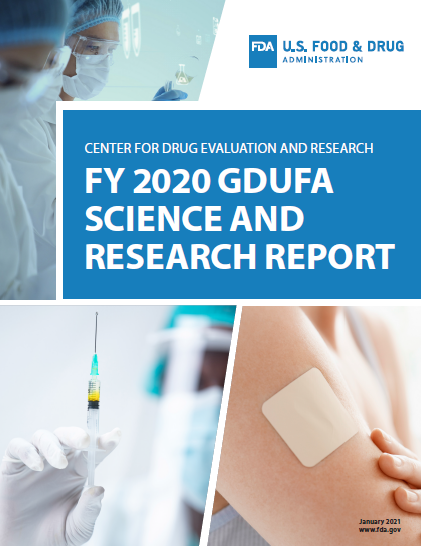FY2020 GDUFA Science and Research Report
Table of Contents
Research Topics
(Each link below will open a 13 MB PDF.)
- Abuse-deterrent Opioid Drug Products
- Complex Injectables, Formulations and Nanomaterials
- Complex Mixtures and Peptides
- Data Analytics
- Drug-Device Combination Products
- Inhalation and Nasal
- Locally-Acting Physiologically-Based Pharmacokinetic Modeling
- Long-Acting Injectables and Implants
- Ophthalmic
- Oral Absorption Models and Bioequivalence
- Patient Substitution of Generic Drugs
- Quantitative Clinical Pharmacology
- Topical Dermatological
Joint Directors’ Message
Sally Choe, Ph.D.
Director of CDER’s Office of Generic Drugs
Michael Kopcha, Ph.D., R.Ph.
Director of CDER’s Office of Pharmaceutical Quality
The Generic Drug User Fee Amendments (GDUFA) established a research program that is implemented through extensive intramural and extramural collaborations. This Directors’ Message is a joint message from the Director of the Office of Generic Drugs (OGD) and the Director of the Office of Pharmaceutical Quality (OPQ), as both offices within the Center for Drug Evaluation and Research (CDER) are significantly involved in GDUFA-funded research collaborations and projects. We also acknowledge other offices within FDA that are closely involved with our GDUFA Science and Research program, such as CDER’s Office of Translational Sciences, FDA’s Center for Devices and Radiological Health, National Center for Toxicological Research, and Office of Regulatory Affairs.
The GDUFA Science and Research program supports the development of additional innovative methodologies and more efficient tools to help establish drug equivalence standards and support the development of, and access to, safe, effective, and high-quality generic drug products for the American public.
In Fiscal Year (FY) 2020, FDA awarded 11 new research contracts and 5 new grants (not including supplements to existing projects) for innovative extramural research projects relevant to generic drugs. FDA also utilized its laboratories and computer systems to conduct more than 50 intramural GDUFA Science and Research projects focused on best using our resources to improve generic drug development and regulatory assessment. These research projects follow the FY 2020 science and research priority initiatives, which fall into the following categories:
- Complex active ingredients, formulations, or dosage forms
- Complex routes of delivery
- Complex drug-device combination products
- Tools and methodologies for bioequivalence and therapeutic equivalence evaluation
GDUFA-funded research provides data supporting the assessment and approval of multiple Abbreviated New Drug Applications (ANDAs) for generic drug products. Laboratory research into advanced analytical technologies and in vitro approaches supported the approvals of first generics for certain complex drug products and equally important, multiple generics of some complex drug products.
Complex drug products are a diverse group of drug products including those with complex active ingredients, dosage forms/formulations, routes of delivery, drug-device combinations, and other complexities. These products are often harder to develop, which means that many face less competition, and therefore can be more expensive and less accessible to the patients who need them.
For example, acyclovir topical ointment, 5%, was originally approved as a new drug product in 1982 and had no approved generics for more than three decades. Practically-speaking, it was unfeasible to develop a generic acyclovir topical ointment, 5%, using the traditional approach (i.e., with a comparative clinical endpoint bioequivalence study) because such a study would likely involve thousands of patients and may still have a high risk of not being able to meet clinically and/or statistically meaningful endpoints. However, based on GDUFA-funded research initiatives and exceptional coordination between OGD and OPQ, more efficient methods for establishing bioequivalence were developed, and now as of this past year there are 15 approved (and multiple marketed) generics of this complex drug product, representing the largest number of approved generics for this type of topical product, which led to exceptional market competition and improved patient access to this important anti-viral medication.
In addition, GDUFA-funded research on modeling directly supported FDA decision-making on several regulatory matters, and these models are now included in some ANDA submissions to support a demonstration of bioequivalence. For example, modeling and simulation substantially contributed to the approval of albuterol sulfate inhalation aerosol, 90 mcg. A state-of-the-art, likelihood-based modeling approach improved the credibility of the pharmacodynamic model with high data censoring and provided key evidence to support the assessment of bioequivalence. Approval of generic albuterol inhalers facilitated access to these critical medical products in response to inhaler shortages and increased demand caused by the novel coronavirus pandemic.
Our GDUFA-funded research collaborations have resulted in significant accomplishments related to developing the scientific basis that supports new and revised product-specific guidances (PSGs) and general guidances for industry, and in refining methods for the scientific evaluation of quality and equivalence for generic drug products.
In FY 2020, we issued 258 new and revised PSGs (124 were for complex products), which provided recommendations for developing generic drugs and generating the evidence supporting ANDA approval. These PSGs helped industry streamline and remove certain risks associated with generic drug product development, and helped FDA to expedite the assessment of ANDAs.
Earlier and enhanced communication between FDA and industry under GDUFA II supports the development of generic drugs, including complex generic drug products, and should continue to help reduce overall time to approval for generic drug submissions. The pre-ANDA program features product development, pre-submission and mid-review cycle meetings with the generic drug industry for complex drug products to help clarify regulatory expectations and provide scientific advice early in product development and during application assessment. In FY 2020, FDA facilitated 79 product development and pre-submission pre-ANDA meetings, which allowed FDA to engage with industry during product development.
The FY 2020 GDUFA Science and Research report provides detailed results for 13 areas of focus, including a summary of research activities, research highlights, comprehensive lists of grants and contracts, and outcomes that the GDUFA Science and Research program funded in FY 2020. The outcomes include a list of PSGs issued in FY 2020 that resulted from relevant research, as well as detailed lists of journal articles, posters, and presentations given in FY 2020. Additional information on outcomes from the GDUFA Science and Research program will be shared in the separate FY 2020 GDUFA Science and Research Outcomes Report, which will be posted on our website once available.
We would like to thank all of our collaborators who contributed greatly to this effort and we look forward to the future scientific achievements that will help further enhance access to safe, effective, and high-quality generic drugs for the American public.



